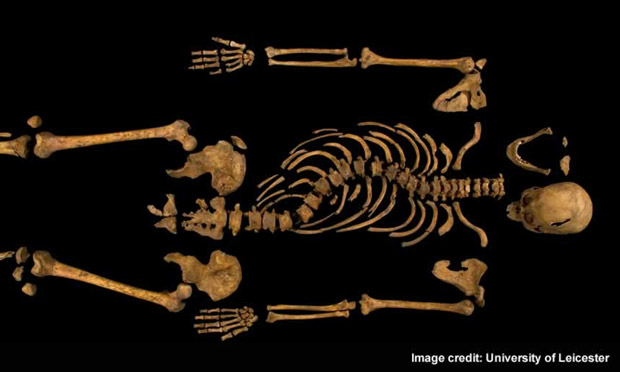
The skull of the skeleton found under a parking lot in Leicester, England, that researchers now say is that of King Richard III
You can see the curvature of the spine. He was known as the hunchbacked king ( A form of scoliosis..)
The bones are laid out in the lab just as they laid in the grave
The search for the long-vilified English King Richard III, who died in battle in 1485 and whose image as a nasty tyrant was immortalized by William Shakespeare, appears to have ended.
In a dramatic Monday morning press conference, researchers from England's University of Leicester announced they had identified "beyond all reasonable doubt" Richard III's skeletal remains. The remains had been unearthed last August by an archaeological team from beneath a parking lot where the friary that reportedly held Richard III's body once stood.For nearly 40 minutes on Monday, a team of scientists and historians reported the results of detailed medical, historical, genealogical, and genetic studies conducted after archaeologists discovered a skeleton that they believed to be Richard III.
Turi King, a geneticist at the University of Leicester, and Kevin Schürer, a genealogist at the school, turned up the most compelling evidence. By poring over historical records and documents, Schürer conclusively identified two of Richard III's living descendants: Michael Ibsen, a furniture maker in London, England, and a second individual who now wishes to remain anonymous.
King took DNA samples from the two descendants and compared them to a sample of ancient DNA obtained from the skeleton from the friary. "There is a DNA match," King told reporters, "so the DNA evidence points to these being the remains of Richard III."
Richard III died at age 32 of injuries he sustained at the Battle of Bosworth in August 1485, and the new evidence fits closely with these records. University of Leicester osteologist Jo Appleby showed two gruesome head injuries that Richard received in his last moments—one likely inflicted from behind by an assailant bearing a halberd, a medieval weapon consisting of an axe blade topped with a spike. In addition, Appleby found several other wounds that she described as "humiliation injuries," likely inflicted on Richard's dead body.
Historical accounts suggest that Richard's enemies stripped his body after the battle and threw his corpse over a horse "and this," says Appeleby, "would have left his body exposed to [humiliation] injuries."
The osteologist's studies also revealed that Richard was a man of slight build who suffered from a medical condition known as idiopathic adolescent scoliosis, a curvature of the spine that developed after ten years of age and that may have brought back pain to the future king. This emerging scientific picture of Richard fits with a description of the king written by John Rous, a medieval English historian, in the late 15th century. According to Rous, Richard III "was slight in body and weak in strength."
The King's enduring image as a cruel despot was cemented by Shakespeare, who portrayed him as a glowering monster so repugnant "that dogs bark at me as I halt by them."
In Shakespeare's famous play, the hunchbacked king claws his way to the throne and methodically murders most of his immediate family—his wife, older brother, and two young nephews—until he suffers defeat and death on the battlefield at the hands of a young Tudor hero, Henry VII.
Thanx to National Geographic



No comments:
Post a Comment
Through this ever open gate
None come too early
None too late
Thanks for dropping in ... the PICs